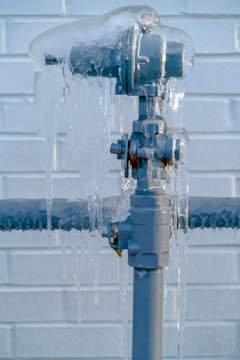Protecting Pipes from Cold Weather Damage: Key Approaches
Protecting Pipes from Cold Weather Damage: Key Approaches
Blog Article
Have you been trying to locate help around Preventing and dealing with frozen pipes?

Cold weather can ruin your plumbing, specifically by freezing pipes. Right here's exactly how to avoid it from taking place and what to do if it does.
Intro
As temperature levels decline, the threat of icy pipelines boosts, potentially resulting in costly repair work and water damages. Recognizing exactly how to avoid frozen pipelines is vital for house owners in cold environments.
Prevention Tips
Insulating at risk pipes
Cover pipes in insulation sleeves or use warmth tape to protect them from freezing temperature levels. Focus on pipelines in unheated or external locations of the home.
Heating strategies
Maintain indoor rooms adequately warmed, especially areas with pipes. Open up cabinet doors to permit warm air to distribute around pipelines under sinks.
How to determine icy pipelines
Look for reduced water circulation from taps, uncommon smells or sounds from pipelines, and noticeable frost on exposed pipes.
Long-Term Solutions
Structural modifications
Think about rerouting pipelines away from exterior walls or unheated areas. Add added insulation to attic rooms, basements, and crawl spaces.
Updating insulation
Purchase premium insulation for pipelines, attic rooms, and wall surfaces. Appropriate insulation assists maintain consistent temperature levels and lowers the danger of frozen pipelines.
Shielding Outdoor Pipes
Garden hoses and outside taps
Disconnect and drain yard hoses before winter season. Set up frost-proof faucets or cover outdoor faucets with shielded caps.
Comprehending Frozen Pipelines
What creates pipelines to freeze?
Pipelines ice up when exposed to temperature levels below 32 ° F (0 ° C) for extended durations. As water inside the pipes freezes, it expands, taxing the pipe walls and possibly creating them to break.
Dangers and problems
Icy pipes can bring about supply of water disturbances, residential or commercial property damage, and pricey fixings. Ruptured pipelines can flooding homes and trigger substantial architectural damage.
Signs of Frozen Pipes
Identifying icy pipelines early can avoid them from bursting.
What to Do If Your Pipes Freeze
Immediate activities to take
If you presume frozen pipelines, maintain faucets open to alleviate stress as the ice thaws. Utilize a hairdryer or towels soaked in warm water to thaw pipes slowly.
Verdict
Stopping icy pipes requires positive measures and quick feedbacks. By comprehending the causes, indicators, and safety nets, home owners can protect their plumbing during cold weather.
Helpful Tips to Prevent Frozen Pipes this Winter
UNDERSTANDING THE BASICS: WHY PIPES FREEZE AND WHY IT’S A PROBLEM
Water freezing inside pipes is common during the winter months, but understanding why pipes freeze, and the potential problems it can cause is crucial in preventing such incidents. This section will delve into the basics of why pipes freeze and the associated problems that may arise.
THE SCIENCE BEHIND FROZEN PIPES
When water reaches freezing temperatures, it undergoes a physical transformation and solidifies into ice. This expansion of water as it freezes is the primary reason pipes can burst. As the water inside the pipe freezes, it expands, creating immense pressure on the walls. If the pressure becomes too great, the pipe can crack or rupture, leading to leaks and water damage.
FACTORS THAT CONTRIBUTE TO PIPE FREEZING
Low Temperatures: Extremely cold weather, especially below freezing, increases the risk of pipes freezing. Uninsulated or Poorly Insulated Pipes: Pipes located in unheated areas, such as basements, crawl spaces, or attics, are more prone to freezing. Insufficient insulation or lack of insulation altogether exacerbates the problem. Exterior Wall Exposure: Pipes running along exterior walls are susceptible to freezing as they encounter colder temperatures outside. Lack of Heating or Temperature Regulation: Inadequate heating or inconsistent temperature control in your home can contribute to frozen pipes. PROBLEMS CAUSED BY FROZEN PIPES
- Pipe Bursting: As mentioned earlier, the expansion of water as it freezes can cause pipes to burst, resulting in significant water damage.
- Water Damage: When pipes burst, it can lead to flooding and water damage to your property, including walls, ceilings, flooring, and personal belongings.
- Structural Damage: Prolonged exposure to water from burst pipes can compromise the structural integrity of your home, leading to costly repairs.
- Mold and Mildew Growth: Excess moisture from water damage can create a favorable environment for mold and mildew growth, posing health risks to occupants.
- Disrupted Water Supply: Frozen pipes can also result in a complete or partial loss of water supply until the issue is resolved.
WHY CERTAIN PIPES ARE MORE PRONE TO FREEZING
- Location: Pipes located in unheated or poorly insulated areas, such as basements, crawl spaces, attics, or exterior walls, are at higher risk of freezing.
- Exterior Pipes: Outdoor pipes, such as those used for irrigation or exposed plumbing, are particularly vulnerable to freezing as they are directly exposed to the elements.
- Supply Lines: Pipes that carry water from the main water supply into your home, including the main water line, are critical to protect as freezing in these lines can affect your entire plumbing system.
- Underground Pipes: Pipes buried underground, such as those connected to sprinkler systems or outdoor faucets, can be susceptible to freezing if not properly insulated.
https://busybusy.com/blog/helpful-tips-to-prevent-frozen-pipes-this-winter/

As a passionate reader about Winter Plumbing Precautions: Preventing Frozen Pipes, I imagined sharing that excerpt was worthwhile. Sharing is nice. You won't know, you may just be helping someone out. Many thanks for taking the time to read it.
Get A Quote Report this page